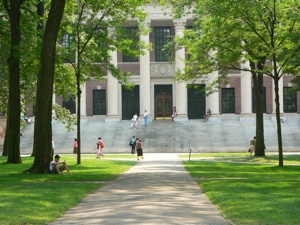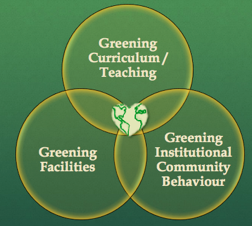Postsecondary Sustainability Education
Postsecondary sustainability education can start in every lecture theatre and every lab, with every professor and every instructor — and every student. It's not only elementary and secondary schools that must make the switch to transformative education for sustainability ... it is just as important at colleges and universities if we want to give our young people a chance at a viable future.


Our students are hopeful and creative, innovative and thoughtful, but most are bored with their lectures and seminars, writing papers and competing for top grades. As educators, we have few answers to their questions about what this university education is for. They see the things they are learning as disconnected from the increasingly urgent and dire warnings they hear and talk about everyday.
— Duane Elverum and Janet Moore
Universities and colleges around the world are hiring campus sustainability coordinators, which is a very good thing. It seems, however, that their first task is to "green" campus facilities. Curriculum is likely to be the last thing on their list, especially as it's seen as the territory of educational professionals: instructors and professors, deans and department heads.
Here, then, are some suggestions for greening the heart of higher education through postsecondary sustainability education.

- Sustainable development is the biggest and most important paradigm shift to come our way in a long time. Yet most of the public, at least in North America, still cannot describe it or put it into practice. Postsecondary institutions can ensure that all students graduate as practitioners of sustainable development by making a course about sustainable development and sustainability mandatory for students in all disciplines. What could this look like?
- Students learn the history, "story," definition, goals, principles, processes and promise of sustainable development.
- The course is taught in a way that respects and models the principles and processes of sustainable development: integrating environmental, social equity, and economic considerations and concerns; putting the needs of future generations and today's less fortunate at the centre of discussions, planning and decision making; using a multi-stakeholder roundtable approach. (See the Three Hats Strategy for ideas.)
- Every student works with students from other disciplines (for example, a history student with a biology student with a commerce student) on a sustainable development project (that relates to their campus, community or country). This is an excellent way to put sustainability theory — and critical and collaborative thinking — into practice.

The concept of sustainability could provide a new foundation for the liberal arts and sciences.... [I]n fact, it would be different in the new focus, added coherence, and stark immediacy that it would provide. Sustainability, after all, is the ultimate liberal art (and science).... By "sustainability" I mean the effort to frame social and economic policy so as to preserve with minimum disturbance earth's bounty — its resources, inhabitants, and environments — for the benefit of both present and future generations.
— Frank H. T. Rhodes, President Emeritus of Cornell University,
in Sustainability: the Ultimate Liberal Art
- No matter what the discipline, every professor and instructor can and should teach in service to the Earth and the future. What does this mean for postsecondary sustainability education?
- Everyone involved must step back to examine the end purpose, the true goal, of what they are teaching — or learning.
- We must accept that by default these days, if we're not consciously and deliberately teaching for sustainability, then we're teaching for UNsustainability.
- We can and should be teaching in ways that reinforce our connection with the rest of Nature, rather than in ways that disconnect us even further.
- Also, postsecondary sustainability education can and should be integrated into every course. The reductionism and "silos" of college- and university-level education no longer serve life on Earth; the environmental crises facing students are all interconnected, and therefore their education should be holistic, integrated and interconnected.
What could this look like for postsecondary sustainability education? Both faculty and students can seek or facilitate opportunities for integration:
- through cross-disciplinary projects (as assignments for more than one course)
- through questions that help students integrate what they've learned in a lecture or a reading with other coursework and the rest of life
- by "ecologicalizing" what is presented in courses
- by giving (or taking) time at the end of every class and course for integrative reflection.

- Students have the right to become fully engaged in integrating sustainability education into their postsecondary studies, by
- inviting (and, if necessary, pressuring) professors to make the links
- respectfully questioning the relevance of seemingly irrelevant learning (there could be some surprises!)
- becoming models of integration — looking for and discussing in class the analogies, metaphors, and relationships that connect different disciplines, different courses, and different topics within courses
- always asking connecting questions, internally and aloud:
- How does this new learning connect me with or disconnect me from the rest of Nature?
- In light of what's happening in the world today, why am I learning this?
- How does this relate to my other coursework?
- How does this relate to my future?
- What could be the impact of what I'm learning on others in the world today and future generations?

Perhaps the most important legacy of the [campus sustainability] movement to date is the discovery that universities (and most large organizations) operate with a substantial degree of unconscious habit and irrationality and that very few people, at even the most senior levels, actually know how they truly function.
This is in part the result of the compartmentalization inherent to large hierarchical organizations. The separation of different disciplines, arenas of responsibility, and tiers of management generally prevent people from understanding the broader context or the overall systems that operate across the institution.
The fact that few individuals understand the broader institutional context, its systems and behaviors, has dire consequences for our efforts to navigate toward sustainability. This is because the demands of sustainability are system-wide and involve changing organizational culture, behaviors and the entire institutional context.
— Leith Sharp, Harvard Green
Greening the Heart of Postsecondary Education

It's not just college or university level curriculum that needs greening. The campus itself and what takes place on campus also need to be greened. Borrowed from the integration principle of sustainable development, this triple Venn diagram shows that postsecondary sustainability education must include all three aspects. (See School Greening for more information.)
For example, AASHE (Association for the Advancement of Sustainability in Higher Education) has an evaluative framework called STARS — Sustainability Tracking Assessment and Rating System, which includes the categories Education and Research (curriculum); Operations (facilities); Planning, Administration and Engagement (institutional community behaviour); plus Innovation.
Universities (and colleges) must start posing some very tough questions — to all their stakeholders:
- What's the purpose of a higher education in the 21st century? Especially in light of the climate change emergency and now inevitable climate catastrophes that huge human populations are facing? What will (or should) postsecondary sustainability education change?
- Are universities educating in service to the Earth and all future generations? Or are they merely self-serving? Are they acknowledging the game-changing urgency of the climate change emergency? Do they recognize that the future of life on the planet is at stake?
- Assuming that universities and their faculty and administration want their mission to be in service to the Earth and all future generations ... HOW MANY ARE ACTUALLY THINKING IN THESE TERMS AND PUTTING THEM INTO PRACTICE?
- Are universities teaching in ways that will safeguard the future of life on Earth? I sometimes say, "If we're not teaching FOR sustainable development, then by default we're teaching for UNsustainable development." But it's also "If we’re not consciously teaching to ensure a future, then we’re likely teaching in a way that will make the future a thing of the past."
- What is the role of the university in a post-peak oil world with an unstable climate? Must traditional roles of research, community outreach, technological innovation, and knowledge creation shift? Should postsecondary education instead be resurfacing the old knowledge and traditional skills (food growing, for example?) while moving at war-time speed on transformative zero-carbon technologies – and ensuring that students are involved in their development?

- Why, when we're considering 21st century educational challenges, do so many educators only think about fancy social media and new technologies? These are a how (to teach) in a world demanding a transformative new what (to teach). They are one tool, not the job at hand (which is postsecondary sustainability education and, frankly, safeguarding life on Earth).
For example, Wikipedia (!!) explains that social media have "substantially changed the way organizations, communities, and individuals communicate" and have "turned communication into interactive dialogue." But this still begs the question: Are we communicating and interactively dialoguing about the things, and in the ways, that will safeguard the future? Or have we — as individuals and as institutions — become enthralled to a giant distraction, a boondoggle that diverts our attention from what's happening to the planet's life support systems?
- And then there are those who are still educating for a world that no longer exists. What must a 21st century university education accomplish? Should postsecondary institutions start teaching people, communities and other collectives how to create the best possible future out of the carbon-constrained and climate-racked chaos we are bequeathing them — in short, how to survive?

At all levels of education, we must be teaching the knowledge, skills, attitudes, and habits of mind and heart that will help our students create the best possible future for themselves. We must bring life and survival back to become the central purpose of education. Both educators and students can start asking the all-important question: Is what I'm teaching / learning serving the Earth, the future, and the children of all species? This is a vital first step in postsecondary sustainability education.
Go from Postsecondary Sustainability Education to the Integration Page
Return from Postsecondary Sustainability Education
to GreenHeart Education Homepage





